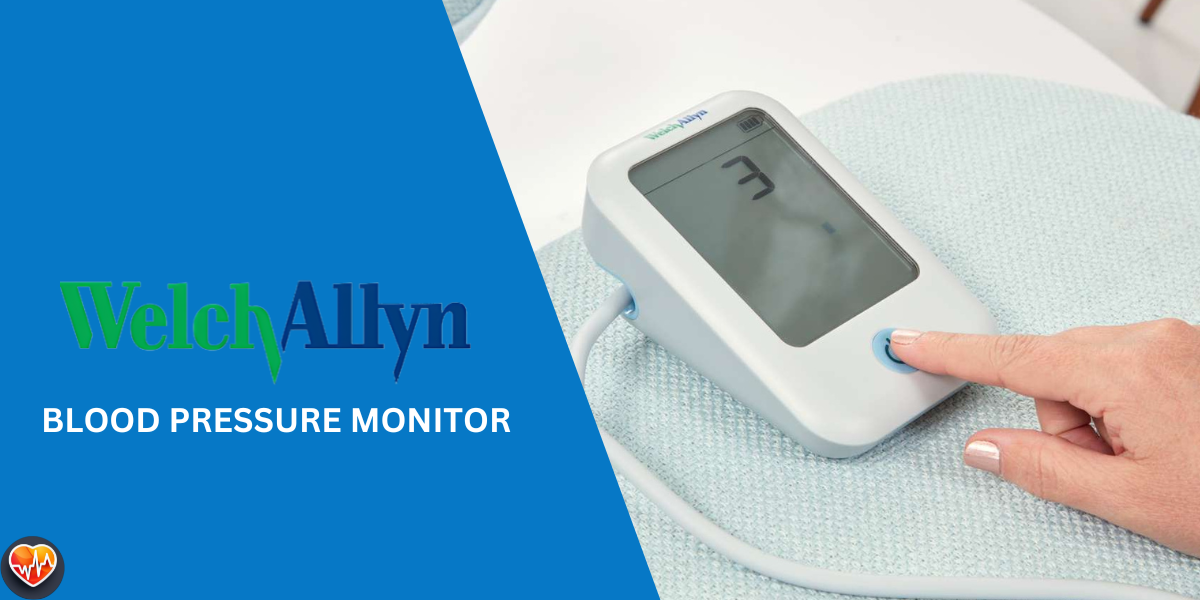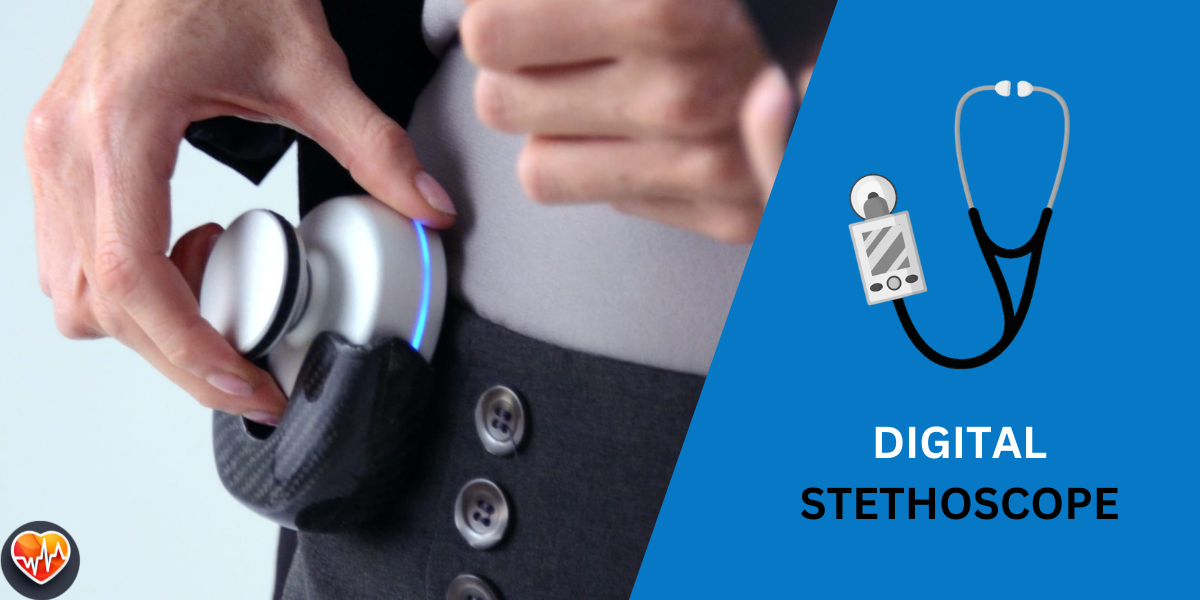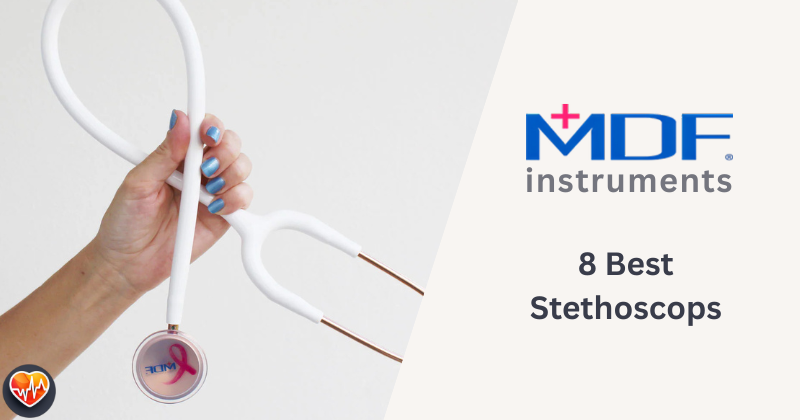
Have you ever wondered how doctors hear those mysterious sounds inside your body?
They use a special tool called a stethoscope!
But there’s more to it than just slapping it on your chest.
Using a stethoscope incorrectly can lead to crucial details slipping through the cracks – like slow bowel sounds, abnormal heart sounds, or unusual breath sounds.
That’s not good!
Want to learn how to use a stethoscope like a pro?
This guide will teach you to hear sounds like heartbeats, normal breath sounds, and even your patient’s blood pressure.
You’ll master the chest piece, ear tips, and everything in between for optimal acoustic performance!
- Get to know your gear: Understand the stethoscope’s parts – earpieces, tubing, and the double-sided chest piece (diaphragm and bell).
- Find a quiet spot: Background noise can hide the sounds you need to hear.
- Patient comfort is key: They need to be relaxed and in a position that lets you listen to various spots (sitting, lying down).
- Earpiece fit matters: Make sure they’re snug and angled slightly forward.
- Hold it steady: Use index and middle fingers for stability; avoid rubbing the diaphragm.
- Pressure is important: Press the diaphragm firmly for high-pitched sounds, and use the bell with very light pressure for low-frequency ones.
- Learn the body’s sound map: Know where to place the stethoscope for the heart, lungs, and even blood pressure readings.
- Practice, practice, practice! The more you listen, the better you’ll understand normal vs. abnormal sounds.
- Keep it clean: Regular cleaning of the stethoscope prevents germ spread.
Stethoscope Basics
Think of a stethoscope as a special set of headphones for your doctor.
But instead of music, it picks up the sounds your body makes!
Let’s break down the different parts and how they help you hear all those secret noises.

Parts of a Stethoscope
- Earpiece: The little nubs that go in your ears. Make sure they fit snugly for complete sound blockage. Twisty headsets let you adjust the tension for the perfect fit.
- Tubing: The rubbery cord that carries sound from the chest piece to your ears.
- Chest Piece: This is the business end! It has two sides:
- Diaphragm: The flat side is like high-powered hearing. It picks up high-frequency sounds like your heart, lungs, and most bowel sounds.
- Bell: The round, hollow side is for low-frequency sounds – think deep rumbles like certain heart murmurs.
How a Stethoscope Works
- The chest piece sits on a patient’s skin, picking up those tiny vibrations our bodies make.
- Sound waves (like invisible ripples) travel up the tubing.
- These ripples reach your ears, helping you hear things like heartbeats and breathing!
Getting the Most Out of Your Stethoscope

Think of using a stethoscope like trying to hear a whisper in a noisy room.
To get the clearest picture of what’s happening inside your patient, you need to set the stage!
Finding a Quiet Space
- Background noise is the enemy! TVs, chatter, and even rustling clothes can hide the sounds you’re after. A quiet room is best.
- Tip: Ask the patient to hold very still, as even movement can create distracting noises.
Patient Comfort and Positioning

- A relaxed patient = easier listening. Please make sure they’re comfy in a way that allows you to reach the spots you need.
- Position matters! Here’s the rundown:
- Sitting Up: Great for listening to the front of the lungs and the heart.
- Lying Down: Best for the back of the lungs and the belly.
- Left Side: Sometimes used to hear specific heart sounds better.
Proper Stethoscope Technique
- Earpiece Check: Angle the earpieces slightly forward into your ear canals – this blocks out distractions.
- Holding Steady: Place the chest piece flat against the patient’s skin. Hold it between your index and middle fingers for stability.
- Pressure Play:
- Diaphragm: Press down firmly for the clearest high-pitched sounds.
- Bell: Use super light pressure. It’s too hard, and you won’t hear low-frequency sounds well.
Bonus Tip: You can also use your stethoscope while taking a patient’s blood pressure! You’ll hear the thumping sounds of systolic blood pressure and diastolic pressure.
Listening to Key Body Sounds
Now it’s time to train your ears!
You’ll learn to tell the difference between normal sounds and ones that might mean something needs a closer look.

Heart Sounds
- The Classic “Lub-Dub”: A healthy heart makes a steady, rhythmic sound. Think of it like two quick drumbeats!
- Listening Locations: Don’t just plop that stethoscopeanywhere. Here’s where to focus:
- Top left of the chest: Best for hearing the mitral and tricuspid valves.
- Top right of the chest: This is the prime spot for the aortic and pulmonic valves.
- Bottom left of chest: Perfect for hearing the mitral valve extra clearly.
- Warning Bells: Strange extra heart sounds, like murmurs or a third heart sound, can sometimes signal a problem that needs a doctor’s attention.
Lung Sounds
- Normal Breaths: Think of a gentle whooshing sound as your patient takes a deep breath. It’s kind of like the wind through leaves.
- Problem Sounds: Crackling, high-pitched musical breathing (wheezing), or absent sounds in some spots can mean trouble.
- Mapping it Out: Don’t listen to just one place! Move your stethoscope across the front and back of the chest, comparing both sides.
Other Uses of the Stethoscope
- Blood Pressure: When the blood pressure cuff is on, you can hear the thumping sounds that signal systolic and diastolic pressure.
- Tummy Troubles: While less common, a stethoscope can sometimes help listen to bowel sounds on a patient’s bare stomach.
Remember, practice is key! The more you listen, the better you’ll become at picking out those normal sounds and the ones that might need a second look.

Additional Tips and Recommendations
To keep your stethoscope in optimum condition it needs some care…
Cleaning Your Stethoscope
- Hygiene is Key! Germs can spread, so always clean your stethoscope routinely to protect yourself and your patients. A simple alcohol wipe will do the trick.
- Avoid harsh cleaners – they can damage the stethoscope parts.
Practicing Auscultation
- Start with the Basics: Listen to a healthy person’s heart and lungs first. This helps you recognize what “normal” sounds like.
- Learning Resources: Check out audio samples of normal and abnormal sounds – there are tons online!

Stethoscope Quality
- A Good Tool Matters: A high-quality stethoscope makes a huge difference in hearing clearly. It’s like comparing blurry glasses to a high-definition camera!
Troubleshooting
- Can’t Hear a Thing? Double-check these stethoscope culprits:
- Eartips facing the wrong way
- Eartips not fitting snugly
- Loose or cracked tubing
- Too much clothing under the chest piece

If you’re still having trouble hearing or you hear concerning just the sounds, always recommend the patient seek professional medical advice.
Extra Notes:
- Tracking a patient’s blood pressure over time can be helpful—a sudden change in systolic or diastolic pressure might indicate a problem.
- Certain heart problems can make a “whooshing” sound called a heart murmur.
- If a stethoscope isn’t cleaned regularly, earwax and dirt can clog the ear. Tips! Swap out old ones for fresh Littmann stethoscope ear tips.
Conclusion
Wow, you’re practically a stethoscope pro now!
Remember these key things:

- A stethoscope isn’t just a fancy necklace; you’ve got to use it right to hear those important sounds, from normal breath sounds to potential warning signs like abnormal breath sounds or strange heart sounds.
- Quiet spaces, comfy patience, and good technique are crucial for getting the best results. Practice finding those upper and lower lobes on the lungs for the clearest listening!
- Your body makes all sorts of interesting noises– learn to tell the normal ones from the ones that might need a doctor’s attention, like abnormal bowel sounds or concerning changes in a patient’s blood pressure (systolic and diastolic).
- Keep your stethoscope clean and in good shape for first-class sound quality! A cracked tube or loose ear tips can lead to a poor acoustic seal, hindering the transmission of body sounds.
Think of your stethoscope as a secret decoder ring for your patient’s body.
With practice, you’ll be amazed at what you can hear!
Here’s a quick checklist to make sure you’re ready to rumble:
- Stethoscope Parts: Check! You can name the different components and know how they work.
- Earpiece fit: Snug and comfy with the proper headset tension. No noisy distractions!
- Holding it Steady: Index and middle finger got it covered.
- Pressure Play: You can switch between firm (diaphragm) for high-frequency sounds and gentle (bell) for those low-frequency vibrations.
- “Sound Map”: You know where to place the appropriate chest piece on the patient’s chest or neck, whether you’re listening to a heartbeat, lungs, the brachial artery for blood pressure, or even a patient’s stomach.
The more you explore with your stethoscope, the more fascinating sounds you’ll discover.
This is a valuable skill that can be used in so many ways.
Imagine using your double-sided Littmann stethoscope to listen to a patient’s bowels or even the higher frequencies of a squeaky lung!
Keep learning and listening, and remember that even those tiny sounds matter, so minimize that ambient noise and tune in!
Frequently Asked Questions
How do I make sure my stethoscope is working properly?
Before using your stethoscope, do a quick check. Tap the diaphragm – you should hear a clear sound. Ensure the tubing isn’t cracked and the ear tips are snug. If it’s been a while, give your stethoscope a routine cleaning for optimal performance.
Can I use a stethoscope to take a patient’s blood pressure?
Yes! Place the stethoscope’s chest piece over the brachial artery in your patient’s arm while inflating and deflating the blood pressure cuff. You’ll hear distinct sounds that help determine systolic and diastolic blood pressure.
What’s the difference between the two sides of the stethoscope chest piece?
The flat side (diaphragm) transmits high-frequency sounds like heartbeats and lung sounds. The bell side, with its hollow shape, is designed to pick up low-frequency vibrations.
My patient seems uncomfortable. Is there anything I can do?
Absolutely! Explain what you’re doing before you begin. A cold stethoscope can be startling, so warm it slightly in your hands first. Ask if the pressure is okay, adjusting if needed.
What should I do if I hear strange or abnormal sounds?
If you hear sounds that concern you (like abnormal heartbeats, wheezing, or absent lung sounds), don’t panic! Refer the patient to a doctor for further evaluation. Your stethoscope is a tool, not a replacement for a medical professional.













